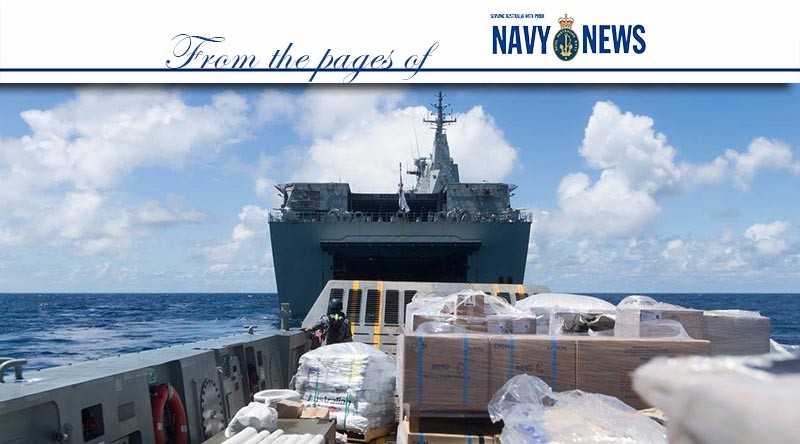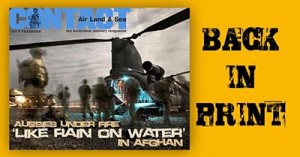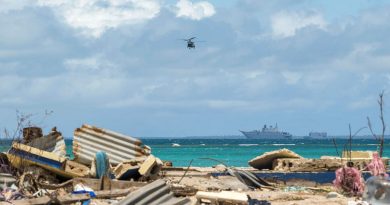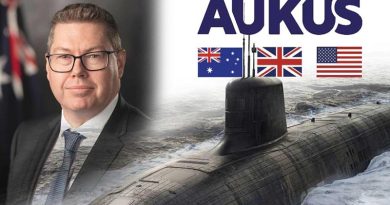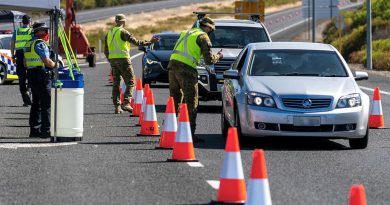HANDS ACROSS THE WATER – Navy in Fiji

The work being done by Navy personnel in Fiji is helping the locals get back on their feet.
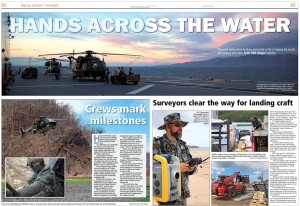
By Lieutenant Will Singer
Crews mark milestones
HELICOPTERS continue to provide valuable rotary wing support to the continuing relief effort in Fiji.
The MRH90s from 808SQN have flown personnel and humanitarian assistance to help sustain Operation Fiji Assist 2016 at the request of the Fijian authorities.
Operating from HMAS Canberra, three aircraft, seven Navy pilots, four aircrew, and 44 engineers make up the detachment, which regularly sees flights of up to 100nm a day.
Their missions have linked various locations in Fiji and have encompassed a wide variety of tasks ranging from the airlift of relief stores through to supporting key leadership engagements.
During the operation, the helicopters and crews of 808SQN have provided direct support to the Fijian Government, DFAT, and the New Zealand Defence Force.
RN exchange pilot LEUT Owen Camplisson said the squadron had achieved significant milestones since flight operations began on March 1.
“This mission was the first time three MRH90s have operated on board a landing helicopter dock over a 10hour deck cycle, seven days a week,” LEUT Camplisson said.
“There was also the first delivery of underslung loads from Canberra to shore in an operational environment for the MRH90.”
The biggest milestone, however, was accomplishing 2000 landings.
During one mission lasting 10 hours, 808SQN flew to small villages in mountainous terrain to deliver six metric tonnes of aid.
Commander Air Canberra CMDR Adrian Capner said he was pleased with the high standard of practice and work ethic of all Aviation branch personnel.
“The small team has worked long hours, from early morning preparation of the aircraft, to way past sunset ensuring the delivery of stores, personnel and equipment to the affected areas.”
An emotional return
For a small group of sailors aboard HMAS Canberra, Operation Fiji Assist is more than a job, it’s personal.
FOR sailors LSET Tevita Vula, ABCD Peter Taylor, ABCD George Cantarakis and ABML Apete Turuva, being in Fiji gives them the opportunity to help family. News that Tropical Cyclone Winston, which struck Fiji on February 20, had caused significant damage to the island nation, created a deep desire to help.
For the sailors, the chance to deploy in support of the Australian whole-of-government response to the Fijian authorities’ request for humanitarian assistance and disaster relief, has been an incredible opportunity.
LSET Vula said the relief work being conducted during the operation had been a great source of pride.
“It has been an honour to be part of the crew and support the people of Fiji,” he said.
AB Turuva said he was proud to be contributing to the mission through his work as a Navy cook, catering for personnel on board and ashore.
The sailor said the arrival in Fiji had not gone unnoticed by those closest to him.
“I recently received a letter of goodwill from my family from Yavusania Village,” AB Turuva said.
Despite the high spirits, the level of devastation to communities where the sailors grew up and fear for the safety of loved ones had made their return to Fiji an emotional experience.
ABCD Taylor was overwhelmed with the hospitality of the Fijian locals when performing translation work onshore.
“I grew up in Savusavu and it was a privilege to go ashore and speak to the elders, chiefs and kids,” he said.
“People are really happy that we are here. “We took the opportunity to share some jokes with the kids and play a game of touch footy.”
ABCD Cantarakis said his experience ashore was equally emotional.
“My work on the island made me realise how lucky we are; the sight of flattened coconut trees was a first for me,” he said “Despite their hardship, the local people offered to feed and accommodate us but we had to politely decline.”
ABCD Cantarakis said they found a compromise by sharing a tea party, complemented with the only thing he had on him, his biscuits from a ration pack. At the time – amidst the devastation – he said it was great to be able to give back a little bit of joy to those who had next to nothing, but offered him so much.
With locals in body, spirit
PERSONNEL of JTF635 took time out from relief operations to attend a service at the Methodist Church in Nasau on Koro Island on March 6.
Joining local villagers, CHAP Max Walker held a sermon in the village which had survived the damaging winds of Tropical Cyclone Winston.
JTF635 personnel gathered for the service and joined in chorus with the congregation singing hymns in English, while the residents of Nasau sang in Fijian.
Outside, the sound of drills and hammers could be heard as engineers from the Army’s 2 Combat Engineer Regiment and Republic of Fiji Military Force continued to add roofs to dwellings.
After the sermon, the chief steward of the church said a special thank you to the Australian guests for their assistance to the Fijian people.
The visiting personnel were chaperoned to a covered area, where they sat with the villagers and listened to their personal experiences and fight for survival during the cyclone.
CHAP Walker said despite questioning why the cyclone came through their island, their spirit remained unbroken.
“The Fijians belong to a church of strong Christian faith,” CHAP Walker said.
“Despite trying to come to terms with the destruction, they are happy.
“People were glad to have us there, the local people saw hope.”
Medical Officer CMDR Ross Mills said the opportunity to be part of Nasau’s congregation for the morning, and see the smiles on the villagers’
faces, was confirmation of the great work being done.
“It is an honour and a privilege to be of service to the Fijian people and a blessing to be in Fiji,” CMDR Mills said.
Personnel begin the task of cleaning up the debris
ADF personnel have conducted work parties with local forces to help clean up the village of Nasau.
HMAS Canberra personnel were tasked to go ashore and assist with the relief effort.
The cyclone’s destructive winds left a debris field ranging from palm fronds and broken glass, through to damaged white goods and major structural components from houses.
The workforce spent the day separating rubble, gathering organic rubbish, stacking timber and salvaging tin.
Materials that could be recycled and reused were salvaged for later use in housing and other structures.
Engineers from the Brisbanebased 2 Combat Engineer Regiment worked with their Fijian counterparts repairing a school’s corrugated roof and clearing fallen trees.
Commander JTF635 CAPT Brett Sonter said that, as with any natural disaster, the first steps in cleaning up were always the hardest.
“When faced with significant destruction of property, cleaning up and finding order is one of the most difficult things a victim has to deal with,” CAPT Sonter said.
“Sometimes all one needs to recover is a helping hand.”
Fijian PM thanks CDF for support
By Captain Megan McDermott
ON a visit to HMAS Canberra stationed off Koro Island, Fiji’s Prime Minister Frank Bainimarama thanked CDF ACM Mark Binskin for the Australian government’s efforts in response to the most devastating cyclone ever to hit Fiji.
Mr Bainimarama said the Fijian people were resilient in the face of hardship but needed and accepted the support of the international community, specifically the men and women of the ADF.
“On behalf of the people of Fiji, and especially those who were affected by the cyclone, thank you all for being here for us,” Mr Bainimarama said.
“Of all the storms that have come through Fiji, none of them have been as devastating.”
Following a tour of the ship and brief of the operation by CO JTF635 CAPT Brett Sonter, ACM Binskin and Mr Bainimarama flew to Koro Island where the bulk of ADF engineering elements were working together with Republic of Fiji Military Forces to restore key infrastructure such as schools, roads and community shelters.
“The devastation is just unbelievable,” ACM Binskin said.
“In fact it’s heart-breaking. But it’s good to see the Fijian people starting to get back on their feet and working very closely with all of us to get the communities up and running again.”
.
.
.
.
Published in Navy Newspaper, 24 March 2016
.
.
.

.
.

